Open gallbladder removal
Definition
Open gallbladder removal is surgery to remove the gallbladder through a large cut in your abdomen.
The gallbladder is an organ that sits below the liver. It stores bile, which your body uses to digest fats in the small intestine.
Alternative Names
Cholecystectomy - open; Gallbladder - open cholecystectomy; Cholecystitis - open cholecystectomy; Gallstones - open cholecystectomy
Description
Surgery is done while you are under general anesthesia so you will be asleep and pain-free. To perform the surgery:
- The surgeon makes a 5 to 7 inch (12.5 to 17.5 centimeters) cut in the upper right part of your belly, just below your ribs.
- The area is opened up so the surgeon can view the gallbladder and separate it from the other organs.
- The surgeon cuts the bile duct and blood vessels that lead to the gallbladder.
- The gallbladder is gently lifted out and removed from your body.
An x-ray called a cholangiogram may be done during your surgery.
- To do this test, dye is injected into your common bile duct and an x-ray is taken. The dye helps find stones that may be outside your gallbladder.
- If other stones are found, the surgeon may remove them with a special instrument.
The surgery takes about 1 to 2 hours.
Why the Procedure Is Performed
You may need this surgery if you have pain or other symptoms from gallstones. You may also need surgery if your gallbladder is not working normally.
Common symptoms may include:
- Indigestion, including bloating, heartburn, and gas
- Nausea and vomiting
- Pain after eating, usually in the upper right or upper middle area of your belly (epigastric pain)
The most common way to remove the gallbladder is by using a medical instrument called a laparoscope (laparoscopic cholecystectomy). Open gallbladder surgery is used when laparoscopic surgery cannot be done safely. In some cases, the surgeon needs to switch to an open surgery if laparoscopic surgery cannot be successfully continued.
Other reasons for removing the gallbladder by open surgery:
- Unexpected bleeding during the laparoscopic operation
- Obesity
- Pancreatitis (inflammation in the pancreas)
- Pregnancy (third trimester)
- Severe liver problems
- Past surgeries in the same area of your belly
Risks
Risks of anesthesia and surgery in general are:
- Reactions to medicines
- Breathing problems
- Bleeding, blood clots
- Infection
Risks of gallbladder surgery are:
- Damage to the blood vessels that go to the liver
- Injury to the common bile duct
- Injury to the small or large intestine
- Pancreatitis (inflammation of the pancreas)
Before the Procedure
Your may have the following tests done before surgery:
- Blood tests (complete blood count, electrolytes, liver and kidney tests)
- Chest x-ray or electrocardiogram (ECG), for some people
- Several x-rays of the gallbladder
- Ultrasound of the gallbladder
Tell your doctor or nurse:
- If you are or might be pregnant
- Which drugs, vitamins, and other supplements you are taking, even ones you bought without a prescription
During the week before surgery:
- You may be asked to stop taking aspirin, ibuprofen (Advil, Motrin), vitamin E, warfarin (Coumadin), and any other drugs that put you at a higher risk of bleeding during surgery.
- Ask your doctor which drugs you should still take on the day of your surgery.
- Prepare your home for any problems you might have getting around after the surgery.
- You'll be told when to arrive at the hospital.
On the day of surgery:
- Follow instructions about when to stop eating and drinking.
- Take the drugs your doctor told you to take with a small sip of water.
- Shower the night before or the morning of your surgery.
- Arrive at the hospital on time.
After the Procedure
You may need to stay in the hospital for 3 to 5 days after open gallbladder removal. During that time:
- You may be asked to breathe into a device called an incentive spirometer. This helps keep your lungs working well so that you do not get pneumonia.
- The nurse will help you sit up in bed, hang your legs over the side, and then stand up and start to walk.
- At first, you will receive fluids into your vein through an intravenous (IV) tube. Soon after, you will be asked to start drinking liquids and eating foods.
- You will be able to shower while you are still in the hospital.
- You may be asked to wear pressure stockings on your legs to help prevent a blood clot from forming.
If there were problems during your surgery, or if you have bleeding, a lot of pain, or a fever, you may need to stay in the hospital longer. Your doctor or nurses will tell you how to care for yourself after you leave the hospital.
Outlook (Prognosis)
Most people recover quickly and have good results from this procedure.
Gallery
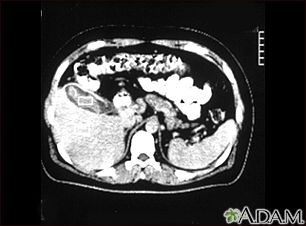
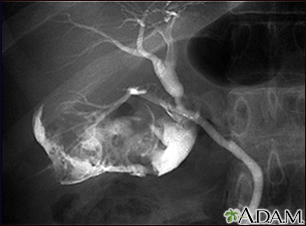
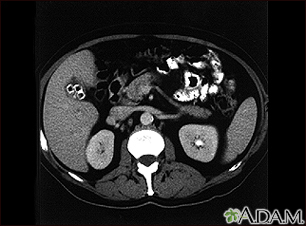
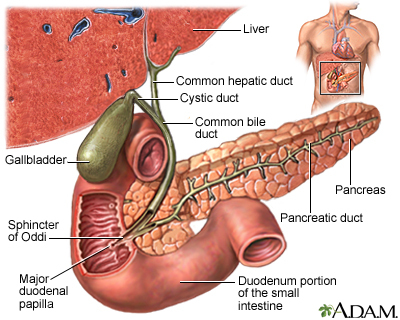
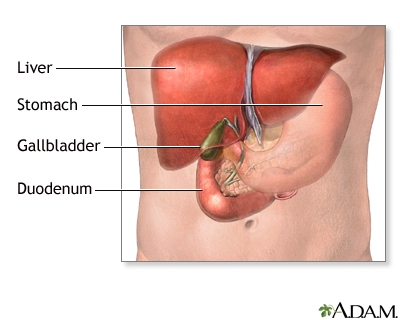
References
Radkani P, Hawksworth J, Fishbein T. Biliary system. In: Townsend CM Jr, Beauchamp RD, Evers BM, Mattox KL, eds. Sabiston Textbook of Surgery. 21st ed. St Louis, MO: Elsevier; 2022:chap 55.
Rocha FG, Clanton J. Technique of cholecystectomy: open and minimally invasive. In: Jarnagin WR, ed. Blumgart's Surgery of the Liver, Biliary Tract, and Pancreas. 6th ed. Philadelphia, PA: Elsevier; 2017:chap 35.
